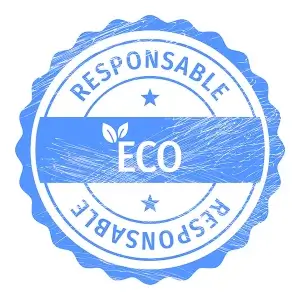Concerns about environmental quality and the circular economy are driving innovation, sustainability and accountability in industries across every sector
Beginning with materials, manufacturing processes and packaging choices – and continuing all the way through the supply chain and product lifecycle – high quality marking can keep work environments safer and more efficient, reduce waste and provide a way to make tangible progress toward ESG initiatives.
High quality marking supports sustainable operations
While sustainable manufacturing is a large umbrella, marking can play a key role in improving sustainability in your manufacturing operations.
- Reduce scrap and rework. Keeping materials out of landfills is a key tenet of sustainable manufacturing. Poorly marked products and packaging that are difficult or impossible to read (by humans or automation equipment) are usually pulled off the line and either discarded or sent back for rework. In either case, it generates waste. Getting clean, readable marks on the first pass is essential. A print controller like the MPERIA® platform that can integrate with back office systems makes the marking process more automated and thus less error prone.
- The right printer saves ink and money. Different print jobs require different printing technology. Digital marking technologies like continuous inkjet (CIJ), thermal inkjet (TIJ), piezo inkjet (PIJ) and drop-on-demand (DOD) valvejet are extremely versatile and efficient. They use less energy than contact printing and other outmoded technologies, and significantly reduce ink consumption. Read our comparison of CIJ and TIJ print technology and TIJ and PIJ for more insights.
- VOC-free inks reduce air quality issues. In some industries, like tire manufacturing, air quality issues in the manufacturing environment are a huge concern. Using the latest generation of VOC-free inks for marking and coding is one way to reduce the air quality burden from volatile organic compounds.
- Drive efficiencies in human power and energy use. Marks facilitate products moving through the production line more efficiently – with inspection marking, instructional information, color coding and 2D bar codes that support automation processes. Here’s where a good print controller with capabilities like barcode validation, increases marking accuracy, accountability and traceability (both internal and external).
Marking reduces waste and keeps products moving
Supply chain efficiency is a perpetual goal, but the pandemic really put it in the spotlight. From managing your suppliers to keeping products moving efficiently until they reach your customers, the quality of your marks – on products, packaging and pallets – can have a significant impact on sustainability.
- Reduce product holds and rejects. It is essential that your marks and labels endure throughout packing, shipping, warehousing and stocking on shelves. Large retailers like Amazon, Walmart and Kroger have strict labeling requirements. Errors in marking, labels that fall off or aren’t applied in the right place and marks that smear or are otherwise unreadable on pallets of products delivered to can result in entire pallets being rejected and products being discarded or having the wrong product go to the customer. This not only generates waste, it has an impact on your company’s reputation and bottom line.
- Improve traceability. High-quality marks are an underpinning of effective traceability. It helps ensure product authenticity, enables quicker responses to product recalls and builds consumer confidence in the sourcing of products they buy. Advanced 2D barcodes take traceability to the next level, providing deeper, richer information that enables faster and more efficient tracking and investigation, from raw materials to store shelves and every point in between.
Marking keeps regulators and customers in the loop
Sustainability and ESG initiatives are rooted in your company’s concern for the planet, regulatory compliance and consumer awareness. Marking helps with all three.
- Regulatory and standards compliance. In addition to bar codes for traceability and inventory tracking, marks on your products can also convey information that’s required for adherence to environmental regulations and standards set by governments, industry associations and vendors. For instance, the American Plywood Association (APA) requires that association marks must be placed on all manufactured wood products. In the UK, products must display the UK Conformity Assessed (UKCA) logo.
- Highlight cutting edge innovation. Marks can convey your company’s commitment to sustainable innovations or highlight your company’s participation in various private and public initiatives to sustainably source raw materials, or to improve supply chain efficiency. For instance, if you just switched to biodegradable packing peanuts, you could let customers know with special marks on the outside of your cartons.

- Convey sustainable product origins. Consumers are more aware of sustainability than ever before. Eco-conscious consumers want to know that products they buy – including food, lumber, packaged goods, tires, appliances and others – were sustainably sourced and manufactured. Using marks to showcase your adherence to sustainability initiatives, like FSC for wood products or organic certifications on food packaging, go a long way toward making your efforts visible. And when your sustainable product has a high-quality 2D barcode, like a QR code that is scannable by smartphone, it not only provides consumers with more information about your product, but it also conveys transparency and underscores your commitment to your customers and to preserving the planet.
When you’re considering all of the ways you can make your products and your operations more sustainable, don’t overlook marking – it’s relatively low-hanging fruit that can make a measurable impact!
Whether it’s our versatile and reliable VIAjet L-Series TIJ printers that produce precise marks, like 1D and 2D barcodes, at extraordinary speeds and on a variety of substrates; our VIAjet T-Series PIJ printers for high-visibility, colorful informational marking and branding; our rugged VIAjet V-Series DOD valvejet printers that give you high-quality, durable marks on metal, paper and pulp, wood, concrete, rubber and plastic or our MPERIA® marking and coding automation platform – we’ve got your sustainable marking and coding covered.
If you’re moving ahead on traceability initiatives or perhaps looking to adopt the latest recyclable packing material, fill out the form below to learn more about how we can help, and to obtain sample marks on your substrate.
